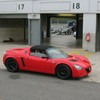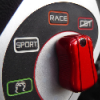I was thinking about buying 2 sets of tyres, one with a hard compound to use to learn the circuit, the lines and generally work on the flow of the circuit, when to brake, when to go full throttle at corner entry etc, then when the times really count put on the softs and go for it.
That's a bad idea. How do you know grip levels if you lean the circuit on different tyres?
Take some time to read through Mike's thread in the project section. The biggest issue he had in 2012 was getting clean laps in. You want to be on the right tyres for the times when the traffic clears and you can put a good lap in.
well it will be the same tyres just a harder compound, its more spending time learning the flow of the circuit etc, what lines are faster and what are slower, I notice alot have a trackday the day before, so if im running hards I should be able to get a full day out of them verses any softer compound.
Finding the grip level on softer rubber will be a learning curve, but being able to adapt to it will be much quicker than munching them trying to learn the circuit as well as the grip level.....if I split the learning into 2 seperate sections it seems more managable, plus by the time i get to qualifying I wont have either bald tyres or heat cycled to hell.
Since its only qualifying and final that count for anything they would be where i would run the softer rubber.
[color=#ff0000;]DO NOT BUY SOFT KUMHOS[/color]
That there is the best advice you will get-ever!
You should stick here, there are a lot of folks who will wish you luck and enjoy following progress.
Have you thought about which wet tyres you will run?
There is a lot of TA exprience here from builders, seter uppers, drivers and crew which between them have bagged five championships in three years including Jamie; that is a pretty strong support network right there.
BTW, be under no illusions, this will cost you... a lot. Even without breakdowns you need to expect to spend between £7K and 10K for a season.
I didnt mean all soft, I was going to go for soft front and medium rear, the reason i thought soft front was because im running 225s so larger surface area per kilo of weight,which will take longer to warm up than 205s and will help the front end to bite in the low speed corners, as mentioned above if your struggling to get a clean lap and spend alot of time circulating at slow speed(im guessing you do this if you get blocked and behind your best time) then it will be easier to turn the tires on the next lap?
Hadnt really thought about wet tyres to much, I was just going to put my 111s wheels on with ad07s and take my time so i dont crash
I was thinking 3 sets of tyres £1800
fuel for the towcar £500
fuel for the race car £300
entry fee £3000
brake pads and discs £1000
servicing items including ball joints, wheelbearings £500
repairs £1000
Does that seem reasonable?
Well im glad to be famous on here.
I do a fair bit of reading on here to gleam any bits of hints, tips and also I enjoy reading peoples project threads, ive known about this thread for a couple of days and havent said anything to see what comments im getting.
In regards of the actual setup of the vehicle, ive been searching for as much advise as I can, having chris randall set the car up(toe, caster, camber etc) and also coming up with my own solutions for wishbone angles to allow me to run lower to help with aero and COG.
Running a very large splitter, canards and end fences, this with my skirts I hope will be enough to balance my wing at a decent AofA, the good thing is though that even if theres not alot of downforce produced by the front I can just wind the wing back(i shouldnt need to as im following the theory of my aerodynamics book closely.
Im sure your loving the idea of turbocharging a rover k series, but im bringing on someone who knows turbod k series fairly well(he did work on the 217mph car) and is very confident he can get a 350bhp engine to hold together as long as we can keep the water temps sensible.
As Nev says, least im trying and doing things my own way, I would rather try, fail and learn from it then sit behind a keyboard and wonder.
If I followed what everyone on that thread said I would have still have stock elise bodywork, have spent £15000 on a supercharged honda engine(which I cant afford) and wonder why im coming last.
Im building mine with the aspirations of winning my class and my ideas reflect my budget, as they say, you can tame a fast car, you cant make a slow car fast.
Rather that maaasive rear wing and diffuser would it not be better to alter the cars undertray? I'm interested in your k turbo charging, I have a landrover freelander project and want to add more horses. I'm thinking itbs as i prefer na but 350 is a nice number. Do you have any more info on the turbo conversion? Good luck on the track, i think anybody behind you will be scared shirtless 
Ive already made a new undertray, it is the full width of the vehicle all the way from tyre to tyre and have end plates to stop air getting underneath, ive just cut a small section at each end for when the car is jacked up to clear the upright.
Im using a turbo technics low compression engine with a vvc head(solid cams) made a manifold which puts the turbo over the top of the engine and a downpipe which goes over the gearbox, running a chargecooler.
I dont mind at all that people wont like the car, I find it interesting peoples opinions on it, the rear uprights wont stay that way at all, they were just there as test pieces to get the wing in the correct position and see how the uprights react to sideway stresses etc, ill be remaking them to come out of the same place but rise to the wing in a different way to reduce there weight.
What is the theory behind the uprights to be that far behind the car?
3 reasons mainly.
1. Everything I have read on aerodynamics state the wing will be more effective further back from the vehicle to try and pick up as much clean air as possible, this means I can run the wing at a less of angle to achieve a certain level of downforce so less overall drag.
2. An effective wing creates a decent low pressure zone directly beneath its cord, im going to try and use that low pressure zone to drag air out from the clam shell(hence me cutting open the number plate zone) this will hopefully assist with keeping the air flowing through and helping with oil temps and ambient heat cooking parts or raising inlet temps
3. If I find that the diffuser is not very effective at the length ive made it I can shorten it down enough at it will interact with the low pressure zone created by the wing to help scavaging the air from under the chassis which in turn makes all of the underbody work more efficiently and create more downforce.
Edited by turbotoaster, 08 November 2013 - 12:42 AM.




















